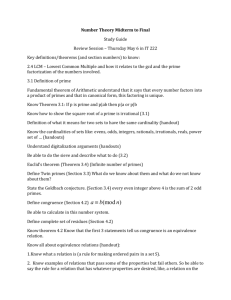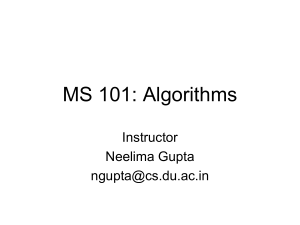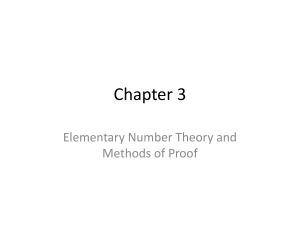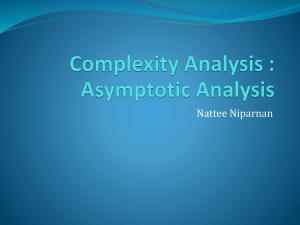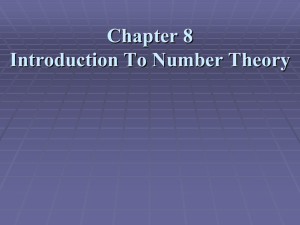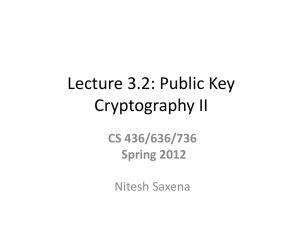Euler Totient Function ø(n)
advertisement
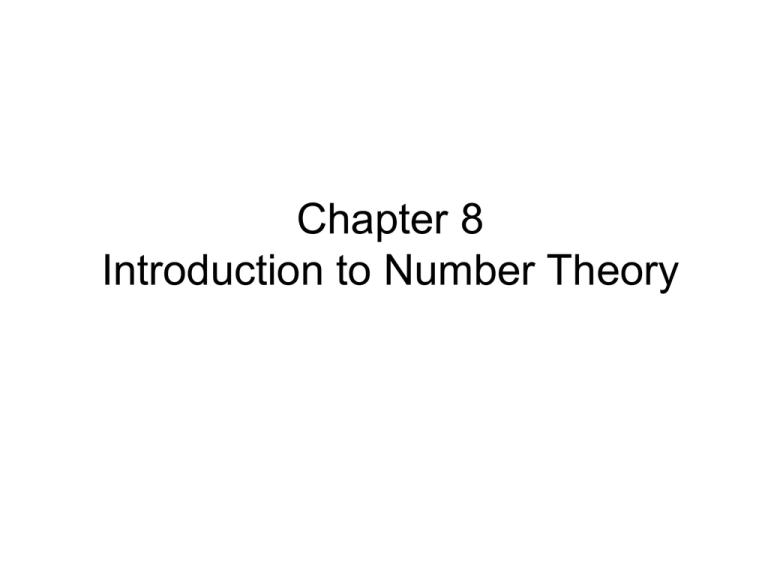
Chapter 8
Introduction to Number Theory
Prime Numbers
• prime numbers only have divisors of 1 and self
– they cannot be written as a product of other numbers
– note: 1 is prime, but is generally not of interest
• eg. 2,3,5,7 are prime, 4,6,8,9,10 are not
• prime numbers are central to number theory
• list of prime number less than 200 is:
2 3 5 7 11 13 17 19 23 29 31 37 41 43 47 53 59
61 67 71 73 79 83 89 97 101 103 107 109 113 127
131 137 139 149 151 157 163 167 173 179 181 191
193 197 199
Prime Factorisation
• to factor a number n is to write it as a
product of other numbers: n=a × b × c
• note that factoring a number is relatively
hard compared to multiplying the factors
together to generate the number
• the prime factorisation of a number n is
when its written as a product of primes
– eg. 91=7×13 ; 3600=24×32×52
Relatively Prime Numbers & GCD
• two numbers a, b are relatively prime if
have no common divisors apart from 1
– eg. 8 & 15 are relatively prime since factors of
8 are 1,2,4,8 and of 15 are 1,3,5,15 and 1 is
the only common factor
• conversely can determine the greatest
common divisor by comparing their prime
factorizations and using least powers
– eg. 300=21×31×52 18=21×32 hence
GCD(18,300)=21×31×50=6
Fermat's Theorem
• ap-1 mod p = 1
– where p is prime and gcd(a,p)=1
• also known as Fermat’s Little Theorem
• useful in public key and primality testing
Euler Totient Function ø(n)
• when doing arithmetic modulo n
• complete set of residues is: 0..n-1
• reduced set of residues is those numbers
(residues) which are relatively prime to n
– eg for n=10,
– complete set of residues is {0,1,2,3,4,5,6,7,8,9}
– reduced set of residues is {1,3,7,9}
• number of elements in reduced set of residues is
called the Euler Totient Function ø(n)
Euler Totient Function ø(n)
• to compute ø(n) need to count number of
elements to be excluded
• in general need prime factorization, but
– for p (p prime)
ø(p) = p-1
– for p.q (p,q prime) ø(p.q) = (p-1)(q-1)
• eg.
– ø(37) = 36
– ø(21) = (3–1)×(7–1) = 2×6 = 12
Euler's Theorem
• a generalisation of Fermat's Theorem
• aø(n)mod N = 1
– where gcd(a,N)=1
• eg.
– a=3;n=10; ø(10)=4;
– hence 34 = 81 = 1 mod 10
– a=2;n=11; ø(11)=10;
– hence 210 = 1024 = 1 mod 11
Chinese Remainder Theorem
• used to speed up modulo computations
• Zm: M = m1m2..mk; gcd(mi,mj)=1 for 1i,j k
• AZm : A(a1,a2,.. ,ak); where ai=A mod mi
for 1ik
• Bijection: Zm Zm1 Zm2… Zmk
• Chinese Remainder theorem lets us work in
each moduli mi separately
• since computational cost is proportional to
size, this is faster than working in the full
modulus M
Chinese Remainder Theorem
A, BZm : A(a1,a2,.. ,ak); B(b1,b2,.. ,bk)
• (A+B) mod M((a1+b1)mod m1 ,.. ,(ak +bk)mod mk )
• (A-B) mod M((a1-b1)mod m1 ,.. ,(ak -bk)mod mk )
• (A B) mod M((a1 b1)mod m1 ,.. ,(ak bk)mod mk )
Chinese Remainder Theorem
• to compute (a1,a2,.. ,ak) from A is just to take
ai=A mod mi
• to compute A from (a1,a2,.. ,ak) from A firstly
compute all Mi=M /mi; Mi0 mod mj for all ji
Primitive Roots
• from Euler’s theorem have aø(n)mod n=1
• consider am mod n=1, GCD(a,n)=1
– must exist for m= ø(n) but may be smaller
– once powers reach m, cycle will repeat
• if smallest is m= ø(n) then a is called a primitive
root of n; a, a2, …, aø(n) are distinct (mod n) and
are all relatively prime to n.
• if p is prime and a is a primitive root of p, then
successive powers of a "generate" the group
mod p
• Not all integers have primitive roots.
• 2, 4, p, 2p have primitive roots, where p is any
odd prime and is a positive integer.
Discrete Logarithms or Indices
• the inverse problem to exponentiation is to find
the discrete logarithm of a number modulo p
• that is to find x where ax = b mod p
• written as x=loga b mod p or x=inda,p(b)
• if a is a primitive root then always exists,
otherwise may not
– x = log3 4 mod 13 (x st 3x = 4 mod 13) has no answer
– x = log2 3 mod 13 = 4 by trying successive powers
• whilst exponentiation is relatively easy, finding
discrete logarithms is generally a hard problem
((ln p )1/ 3 (ln(ln p ))2 / 3 )
• The time complexity to find x isO(e
)
